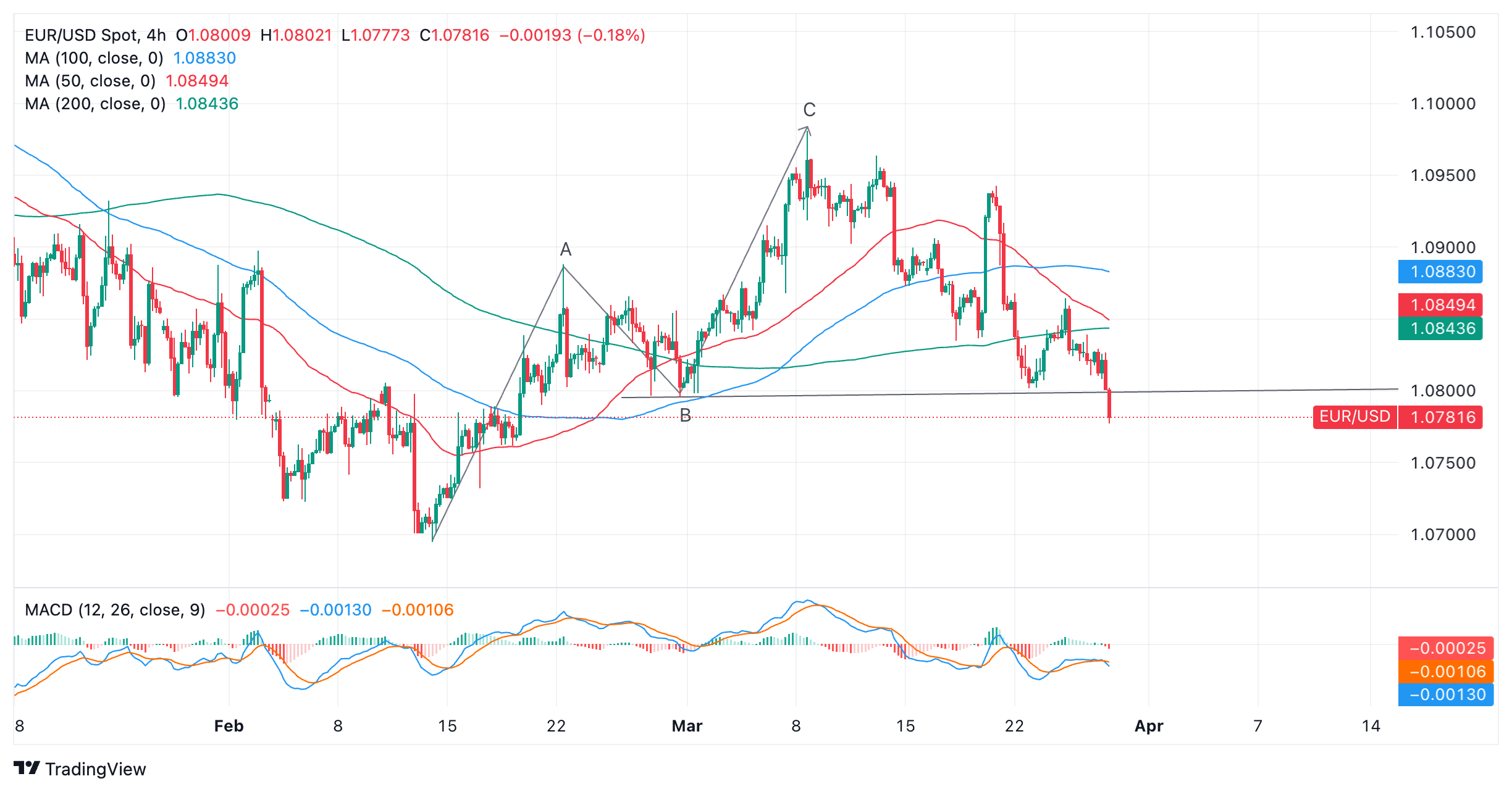- EUR/USD takes another step lower on poor German Retail Sales data.
- Subdued consumer spending levels in Germany increase the probability the ECB will cut interest rates soon.
- This contrasts with the US, where Fed officials are advocating a delay in rate cuts.
EUR/USD sells off on Thursday, breaking below key support at 1.0800 after the release of subpar German Retail Sales data raised further concerns over the health of Europe’s largest economy, weighing on the Euro (EUR). The pair is also pressured lower by a backdrop of the Federal Reserve (Fed) increasingly looking like it will delay cutting interest rates in light of more robust economic data and stickier inflation.
EUR/USD downtrend continues on fears Fed could delay cuts
EUR/USD’s move down extends the short-term downtrend that started after the rollover from the March 8 highs in the 1.0980s. The main catalyst appears to be the diverging commentary from rate-setters at the US Federal Reserve (Fed) and European Central Bank (ECB).
Whilst at the beginning of March the ECB was signaling it would cut interest rates by June and the Fed potentially by as early as May, recent higher-than-expected US data and sticky inflation has led many Fed officials to question whether it may be too early to start cutting interest rates.
The view the Fed may keep interest rates higher for longer has supported the US Dollar (USD) because higher interest rates tend to attract more foreign capital inflows. This is bearish for EUR/USD, which measures the buying power of a single Euro in USD terms.
On Wednesday, Federal Reserve board member Christopher Waller added his voice to those advocating a delay, saying that “there is no rush to cut the policy rate,” in a speech to the Economic Club of New York, according to Reuters.
ECB officials, on the other hand, have cleaved increasingly to June. Eurozone economic data has been on the whole disappointing compared to US data, although persistently high wage inflation still concerns some policymakers.
EUR/USD took another step lower on Thursday after German Retail Sales in February showed shoppers on the whole tightening their purse strings. Weakening consumer spending is another sign inflation will come down further, prompting the ECB to cut interest rates.
Retail Sales fell 2.7% YoY in Germany, which was far below estimates of a 0.8% decline, according to data from Statistisches Bundesamt Deutschland. Month-on-month the 1.9% decrease must have come as a shock after economists predicted a 0.3% rise.
Friday’s US core Personal Consumption Expenditures (PCE) Price Index data for February – the Fed’s preferred gauge of inflation – is likely to be an even more important release for EUR/USD.
A higher-than-expected result could push even further back the time when the Fed is expected to cut interest rates, with negative consequences for the pair.
ניתוח טכני: EUR/USD ממשיך לדחוף למטה
EUR/USD extends the dominant short-term downtrend that started at the March 8 high. It has now broken below key support at around 1.0800.

אירו מול דולר אמריקאי: גרף של 4 שעות
The pair formed a three wave price pattern called a Measured Move back in February and early March and the low of wave B provided the underpinning for key support at just above 1.0800.
If the break in progress proves decisive it would signal a continuation of the downtrend even lower, to the next target at 1.0750, followed by the February lows at roughly 1.0700.
הפסקה מכרעת היא כזו המאופיינת בנר דובי אדום ארוך שפורץ בצורה נקייה את המפלס ונסגר ליד הנמוך שלו, או שלושה נרות למטה ברציפות שפורצים את המפלס.
לחלופין, מהלך מעל רמת 1.0950 יעמיד בספק את תקפותה של מגמת הירידה לטווח הקצר.
יורו שאלות נפוצות
האירו הוא המטבע של 20 מדינות האיחוד האירופי השייכות לגוש האירו. זהו המטבע השני הנסחר בכבדות בעולם מאחורי הדולר האמריקאי. בשנת 2022 היא היווה 31% מכלל עסקאות המט"ח, עם מחזור יומי ממוצע של למעלה מ-2.2 טריליון דולר ליום. EUR/USD הוא צמד המטבעות הנסחרים ביותר בעולם, המהווה כ-30% הנחה על כל העסקאות, ואחריו EUR/JPY (4%), EUR/GBP (3%) ו-EUR/AUD (2%).
הבנק המרכזי של אירופה (ECB) בפרנקפורט, גרמניה, הוא בנק העתודה של גוש האירו. ה-ECB קובע את שיעורי הריבית ומנהל את המדיניות המוניטרית. המנדט העיקרי של ה-ECB הוא לשמור על יציבות מחירים, כלומר שליטה באינפלציה או גירוי צמיחה. הכלי העיקרי שלה הוא העלאה או הורדה של ריבית. ריביות גבוהות יחסית - או ציפייה לריביות גבוהות יותר - לרוב יועילו לאירו ולהיפך. מועצת המנהלים של ה-ECB מקבלת החלטות בנושא מדיניות מוניטרית בפגישות המתקיימות שמונה פעמים בשנה. ההחלטות מתקבלות על ידי ראשי הבנקים הלאומיים בגוש האירו ושישה חברים קבועים, כולל נשיאת ה-ECB, כריסטין לגארד.
נתוני האינפלציה של גוש האירו, הנמדדים במדד המחירים לצרכן הרמוני (HICP), הם מדד אקונומטרי חשוב לאירו. אם האינפלציה תעלה יותר מהצפוי, במיוחד אם מעל ליעד 2% של ה-ECB, זה מחייב את ה-ECB להעלות את הריבית כדי להחזיר אותו לשליטה. ריביות גבוהות יחסית בהשוואה למקבילותיה בדרך כלל יועילו לאירו, שכן היא הופכת את האזור לאטרקטיבי יותר כמקום למשקיעים גלובליים להחנות את כספם.
פרסומי נתונים מודדים את בריאות הכלכלה ויכולים להשפיע על האירו. אינדיקטורים כמו תמ"ג, ייצור ושירותים PMI, סקרי תעסוקה וסנטימנט צרכנים יכולים כולם להשפיע על כיוון המטבע האחיד. כלכלה חזקה טובה לאירו. לא רק שהוא מושך יותר השקעות זרות, אלא שהוא עשוי לעודד את ה-ECB להעלות ריביות, מה שיחזק ישירות את האירו. אחרת, אם הנתונים הכלכליים חלשים, האירו צפוי לרדת. הנתונים הכלכליים של ארבע הכלכלות הגדולות בגוש האירו (גרמניה, צרפת, איטליה וספרד) משמעותיים במיוחד, שכן הם מהווים 75% מכלכלת גוש האירו.
שחרור נתונים משמעותי נוסף עבור האירו הוא מאזן המסחר. אינדיקטור זה מודד את ההבדל בין מה שמדינה מרוויחה מהיצוא שלה לבין מה שהיא מוציאה על יבוא במשך תקופה נתונה. אם מדינה מייצרת יצוא מבוקש מאוד אז המטבע שלה יזכה בערכו אך ורק מהביקוש הנוסף שנוצר מקונים זרים המבקשים לרכוש מוצרים אלה. לכן, מאזן סחר נטו חיובי מחזק מטבע ולהיפך עבור יתרה שלילית.
Source: https://www.fxstreet.com/news/eur-usd-pushes-lower-after-disappointing-german-retail-sale-202403280833